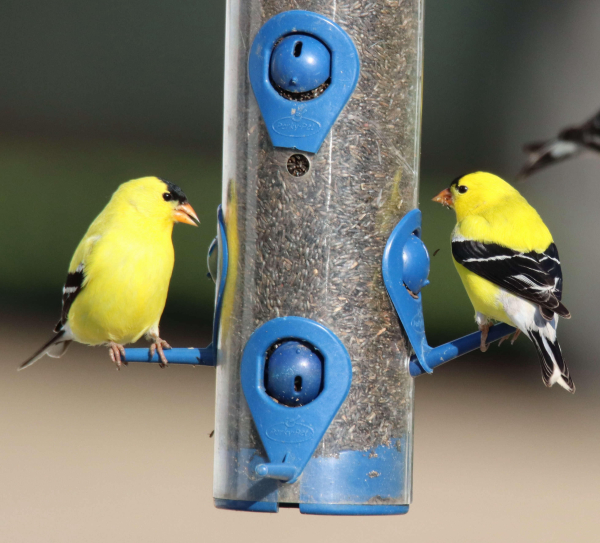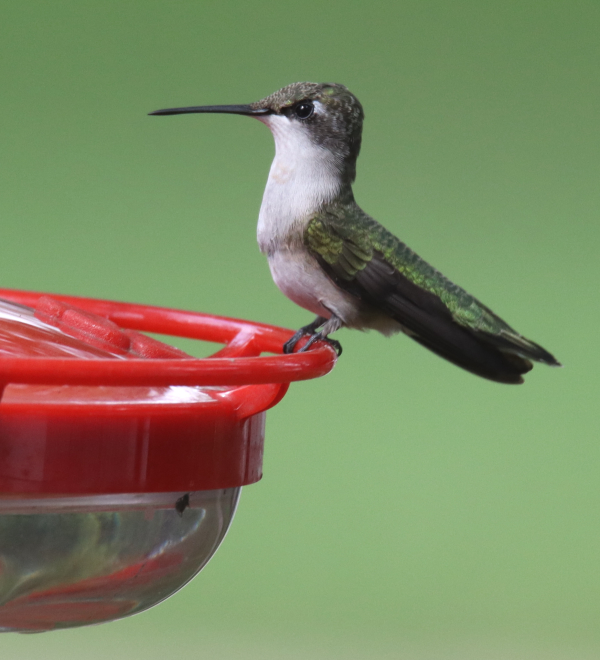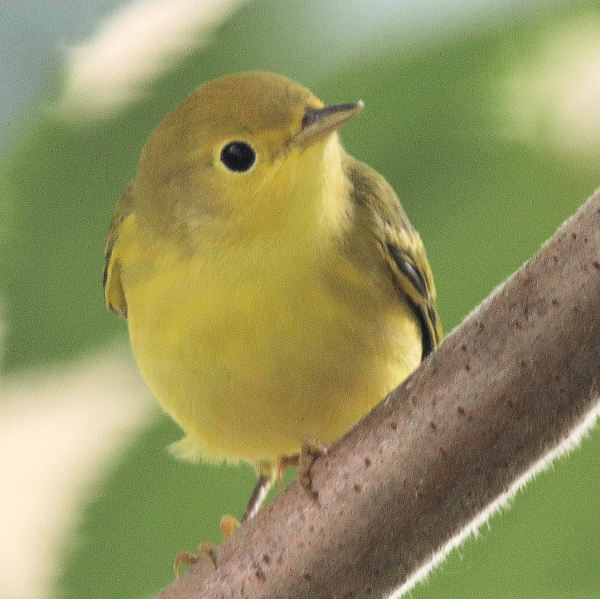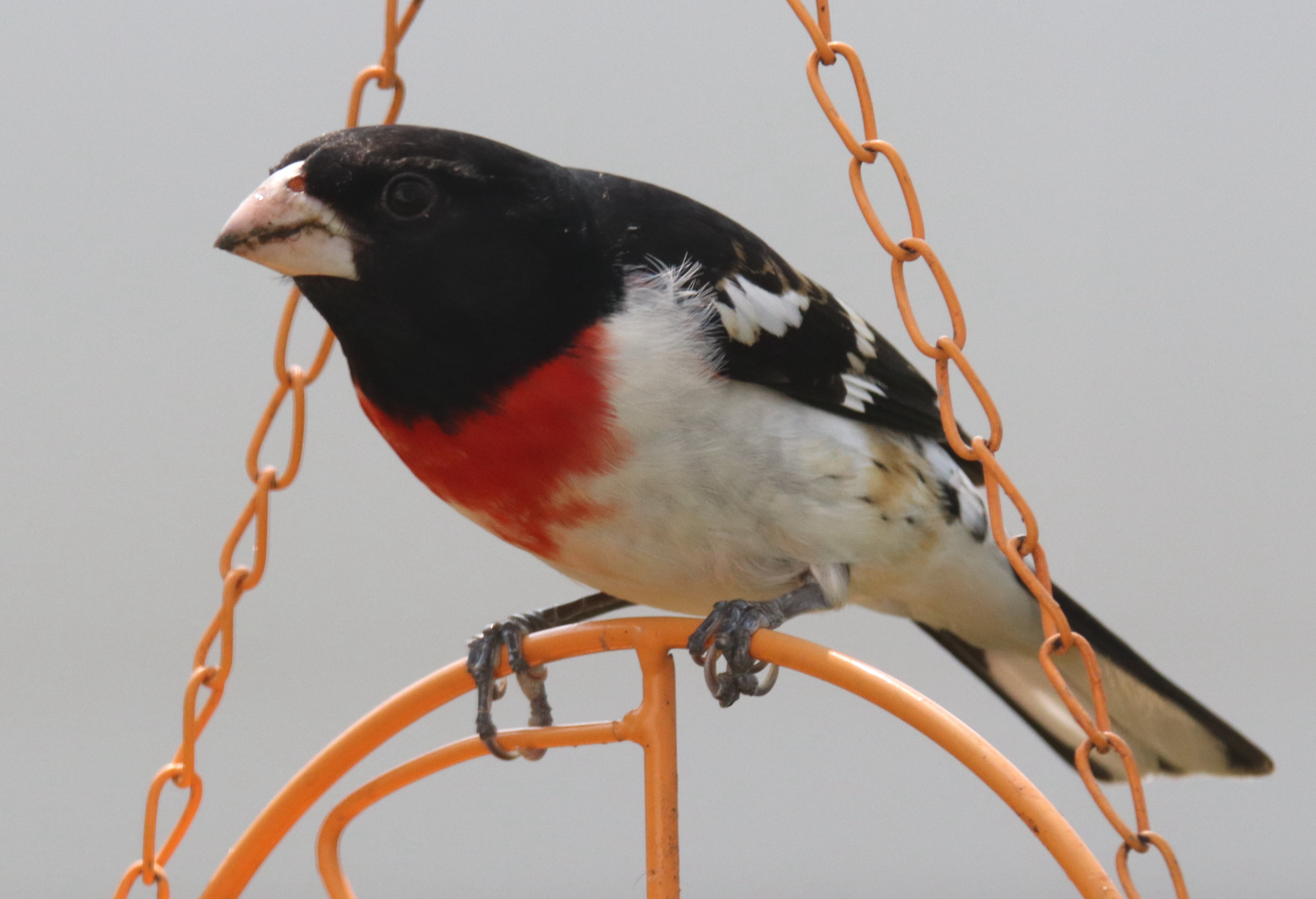Switch to a May Feeding Plan




With the return of feeding station favorites including goldfinches, hummingbirds, orioles, and a variety of migrants that are looking for a feeding and watering stopover site, May is an exciting time at feeders across the continent. But if you haven’t already transitioned to a Spring Feeding Station Plan, now is the time to activate a May Feeding Plan. It’s easy, but you don’t want to miss out on any of May’s exciting birds as they transition to summer nesting areas – maybe even into your neighborhood.
That’s right, by providing a reliable food source you can attract a couple pairs of each species to find a nesting location nearby and provide you with months of enjoyable observations of these beautiful, interesting birds. For goldfinches – American Goldfinches as well as Lesser and Lawrence’s Goldfinches in the Southwest – it’s easy; provide nyjer thistle seeds as usual, along with fresh water, and cross your fingers.
Orioles
For orioles, it’s sometimes even easier! All species of orioles are attracted to the color orange, and they feed voraciously on oranges sliced in half during migration. But the real oriole magnet is grape jelly, so a small jar or bowl of jelly surrounded by orange halves will draw orioles to your feeding station as soon as the first oriole arrives. Now that’s not to overlook orioles’ interest in sugar-water nectar feeders. They will visit a hummingbird feeder, but it’s best to provide nectar in an oriole feeder that has some orange color to attract them initially, and provides bigger perches than most hummingbird feeders.
We’ve found that sugar-water nectar is the least attractive oriole offering, and orioles seem to lose interest in sliced oranges after the migration push; but they relish grape jelly throughout their migration and nesting season during spring and summer. By providing this irresistible mix of foods for orioles – grape jelly, orange halves, and sugar-water nectar – you can test the attractiveness of each offering in your location and the interest in each food among the species of orioles visit your feeding station.
By providing these three foods at our feeding station and thereby establishing a never-ending food source for orioles, we have had excellent luck enticing a couple pairs of two species of orioles to end their migration and nest in our neighborhood, which provides oriole thrills for months! By comparison, when we only offered sliced oranges, orioles didn’t congregate during migration stops, and no orioles nested in the area. Grape jelly has made all the difference to attract many orioles during migration, and enticing pairs to nest in the area through the summer months. When resulting nestlings fledge, the adult orioles bring them to the oriole feeder and the young orioles continue to visit, as do the adults, until they migrate south in early September.
Hummingbirds
It’s pretty easy to attract and keep hummingbirds returning just by providing sugar-water nectar in a hummingbird feeder. Similar to orioles being attracted to the color orange – at least initially – hummingbirds are most attracted to the color red, so it’s best to have a feeder with at least some red color to facilitate their initial interest. By providing a 4-to-1 water to sugar ratio in our nectar, we are trying to best approximate the sugar content in flower nectars. (Alert: Don’t try to provide a “more natural” or “more healthy” option to white sugar by offering a honey-water or brown sugar-water mix – they are not healthy ingredients for any hummingbirds.)
Keep your hummingbird feeders clean, your nectar fresh, and keep feeders filled throughout the season, even if hummers are absent a couple weeks during summer – they will return. Sometimes hummingbirds, especially males, will leave an area to mate or nest in another locale, then return after their mating period.
As noted in last week’s Backyard Birding article, you can add flowering potted plants to your feeding station, balcony, patio, deck, or any location you choose. If they are potted, you can move them at will to different locations, and you can add new plants through the season. Hummingbirds prefer red tubular flowers, which tend to have the highest sugar content in their nectar, but yellow and orange flowers are also favorites. Of course, if you have the space, it’s great to develop a hummingbird garden that features hummingbird favorites that provides a second option to nectar feeders.
More Variety
Providing a fresh water source in a bird bath or another water feature will attract the greatest variety of birds, potentially enticing a variety of warblers, thrushes, buntings, native sparrows, grosbeaks, and more. The sound of moving water, that tinkling dripping sound, will attract new birds to your water because migrating birds listen for the sound of flowing water, from a spring or stream or melt water. That’s where drippers, misters, and small solar fountains make even the simplest bird bath much more attractive to birds you may never see without the moving water sound to attract them.
Many birds shift from eating seeds to feeding on bugs during spring, so seeds and nuts and such may not be utilized as much, but it’s worth keeping at a small platform seed feeder to keep doves, native sparrows, quail, and other species interested. Then too, you may be able to attract rarer species during migration, such as Harris’s Sparrows and towhees – Spotted, Eastern, California, Abert’s, and more.
It’s also important to continue to provide suet, which will attract a broad variety of birds, including the regular woodpeckers and nuthatches, but some warblers and bluebirds might utilize suet too. However, it’s best to switch over to a no-melt summer suet if you haven’t done that already. Many of us prefer a no-squirrel “hot pepper suet” that has chili pepper mixed in, which squirrels and most mammals distain, while birds appear unaffected by its qualities.
A great addition to suet offerings, and a great treat for birds, is Bark Butter – proven to attract no less than 151 different species of birds nationwide. It’s a mix of suet, peanut butter, and corn that’s only available from Wild Birds Unlimited stores and online, and it comes in a spreadable form, a pellet form, and a suet cylinder form. See https://www.wbu.com/products/bark-butter/bark-butter/
Window Feeders
Spring is also a great time to add a window feeder or two. You can get any number of different kinds of smaller window feeders for hummingbirds, orioles, suet eaters, seed eaters, and combination window feeders. Duncraft offers more than 50 different kinds of window feeders to choose from, so take a look at https://www.duncraft.com/Window-Bird-Feeders?view_all
Some inexperienced birders take down their feeders after winter snow melts and northern finches and other seed-eaters migrate north, but spring offers a whole different ball game with different feeding options for different species. We know spring migration brings fun surprise visitors to our feeding stations and water features, and it provides a transition to summer feeding strategies that make our yards all the more attractive, and all the more beneficial, for a variety of exciting birds.
Share your birding experiences and photos at editorstbw2@gmail.com








